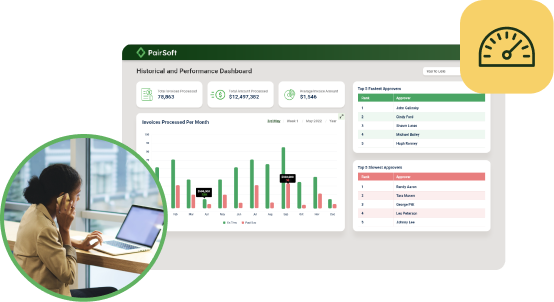
PairSoft
The strongest AP automation, document management, procurement, and fundraising automation platform for mid-market and enterprise companies with integrations to your ERP system.
View all posts by PairSoftPairSoft • October 1, 2021

An Inside Higher Ed survey found that 71% of chief business officers agreed that higher education institutions are facing serious financial difficulties.
As colleges and universities face ever-increasing costs and decreased funding, higher education procurement leaders are becoming strategic campus partners, tasked with reducing overhead and promoting operational efficiency at every stage of the procurement cycle.
Here we’ve highlighted five ways higher education procurement leaders can optimize their organization’s spend management processes, adding value, reducing costs, and promoting best practices.
Spend stakeholders may be a mix of administrators, faculty, and perhaps even students. They may work from multiple locations and at odd hours, travel frequently, and have varying degrees of interest in promoting your institution’s long-term financial health.
But these users across the organization do have one thing in common: they expect the convenience of using consumer-like technology, including mobile apps in the workplace.
Your procurement process should be mobile. By providing the ability to access requisition and expense reporting tools from smart phones or tablet devices, you promote and encourage use of the tools, keeping more spend visible and under your direct control.
Built-in data controls, alerts, and exception routing in the apps ensure your organization’s business processes are honored throughout.
In order to effectively manage spend, you have to be able to see it. Within most higher education organizations, spend data likely exists in several different places.
Procurement professionals can help their organizations become more data driven, by leveraging a spend management solution to standardize, aggregate and combine information to create a true picture of the organization’s total spending, so you can see:
Research by The Hackett Group found that it can cost between $700 and $1,400 in internal costs to source each supplier, set them up in internal systems, transact with them and manage the relationship on an ongoing basis.
The research found that consolidating suppliers reduces direct purchasing costs and lowers procurement and supplier management costs—and ultimately minimizes procure-to-pay (P2P) costs.
Guided buying catalogs and PunchOut capabilities help ensure that your users are purchasing from the select list of vendors you have negotiated pricing with. They minimize data entry time by using predefined vendor items, pricing and accounting information and provide a simple and intuitive user interface.
A recent IDC study of organizations using cloud-based expense management solutions found that, on average, organizations that implement a connected spend management system reported a 70% time saving on expense reports and a 35% increase in employee compliance.
By making it simple and intuitive for employees to capture and submit expenses—using technologies including OCR and machine learning—and by establishing a tailored workflow for the approval process, higher education organizations can streamline expense reporting, boost visibility into the process, and ensure employees are paid quickly and accurately.
Educational institutions live and breathe by their budgets. With limited funds stretched across locations, departments, and programs, budgetary control is vital at every stage of the procurement cycle.
However, department heads shouldn’t spend their time being budget police, and staff members shouldn’t have to chase down budget figures prior to making a purchase request.
By incorporating the procurement budget and spend tracking details right into your purchase requisition and approval workflow, everyone can see at a glance what the spend management parameters are.
By building rules and budgetary controls right into your procurement system, you can ensure that your staff doesn’t overspend. For example, if there isn’t enough money left in a department’s budget to cover an expense, the system can automatically flag the transaction, or even stop the transaction from going through.
Spend management solutions help higher education procurement professionals deliver a value proposition to their organizations.
Organizations can standardize processes across users, manage budgets across multiple departments and campuses, drive savings through better contract compliance and organizational spending limits, and lower direct purchasing costs.
Users can spend less time on procurement-related activities and more time on projects that have a greater impact on the university. Overall, by bringing significantly more spend under management, colleges and universities can deliver unprecedented campus-wide savings and rapid ROI.
Read how PairSoft clients are leveraging our spend management solutions to lower procurement costs, increase purchase visibility, and bring more spending under direct control here.

